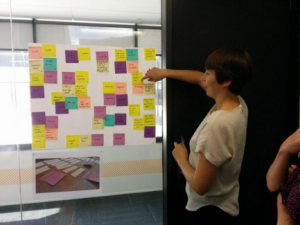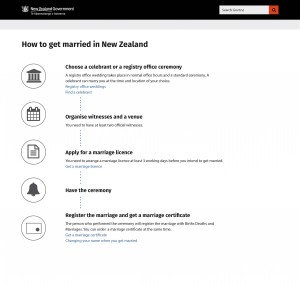We’ve been engaged by the Department of Internal Affairs' Births, Deaths and Marriages, Citizenship, Authentications and Translations group to improve their website and transition the births, deaths and marriages content to Govt.nz. We've just completed a discovery phase to see if we can help people get related tasks done online. We had Contact Centre representatives were involved right from the start, which turned out to be one of the best decisions we made. Their superior user knowledge and drive to help improve the user experience helped us to prioritise the most important needs, and also understand where users are having problems with the current website. Here’s a case study about what users want to know about getting married, and how we’ll help them.

Designer Meg Howie holding a workshop with call centre staff
Start with data
We’re dealing with the big life events of birth, death and marriage, and it’s an emotional ride. Google Adwords is a free online tool that shows what people are searching for in Google (figures are searches per month), and has given us some user insights in these areas:
- 90 for ‘who will I marry’?
- 30 for ‘man marries pillow’
These give us an interesting window into the human condition, but for this piece of work we’ll focus more on the 460 people who search for ‘marriage certificate’ per month.
We’re following the agile theory that the top needs should be prioritised. Google Adwords , Google Analytics and Contact Centre data sources help us understand what people need from government, how much demand there is for each need, and how they're interacting with services.
Data showed us:
- ‘marriage certificate’ is the most searched-for term in Google and is therefore a popular need
- the most-visited marriage-related pages on the DIA website, including over 100K unique pageviews for Get a marriage licence last year
- over 2.5K people searched for ‘divorce’ on the DIA site, but divorce information is provided by the Ministry of Justice
- Contact Centre data revealed that marriage is the second-most called about topic, with over 30K calls last year
Contact Centre insight
The Contact Centre staff provided invaluable insight about user frustrations that data doesn't reveal. They told us:
- there’s a lot of marriage information on the DIA site to wade through; people call because they’re worried they haven’t covered all necessary steps
- it’s hard to find the locations of registry offices online (data supports this - on the top 5 marriage pages there were 350 searches for ‘registry office’ in the last year)
- people get confused about the difference between marriage licences and certificates
- overseas visitors are often confused about how easy the process is to get married in NZ, and often call to double-check they've got the right information
Govt.nz design solution
Our solution to this tangled web of marriage information is to provide a high-level timeline covering the different steps to getting married, including the difference between certificates and licences (see an example of what this could look like below), and provide contact details for registry offices. Further user research revealed that people want to see photos of the registry offices to decide whether to hold their ceremony there, so we’re planning to publish these.

How to get married in New Zealand: Choose a celebrant or registry office ceremony, organise witnesses and a venue, apply for a marriage licence, have the ceremony, register the marriage and get a certificate.
As for all the ‘divorce’ searches we uncovered through Google Analytics, we’ll be making sure the right audience finds this information. Our aim is to channel people before they end up on the pages about marriage, as seeing this content when planning a wedding wouldn't be the most positive user experience.
This is just one example of the valuable insight we've gained. By starting with the Contact Centre we've been able to find the biggest challenges for the most users right from the start. We’re conscious that we need to cover all births, deaths and marriages content, and are being methodical in our audit and content plan. But we also want to make sure we nail the big improvements for the largest audience. This up-front insight means we've been able to target further user research sessions and analytics to reveal gaps in our knowledge, or dig deeper into known issues.
A big thanks to Lynne Walker, Hannah Wylie, and Salome Pule from the DIA Customer Services team for taking the time to work with us. We’re hoping to continue this collaboration past Govt.nz go-live to get an effective user feedback loop established, where we all work together to refine the user experience.


